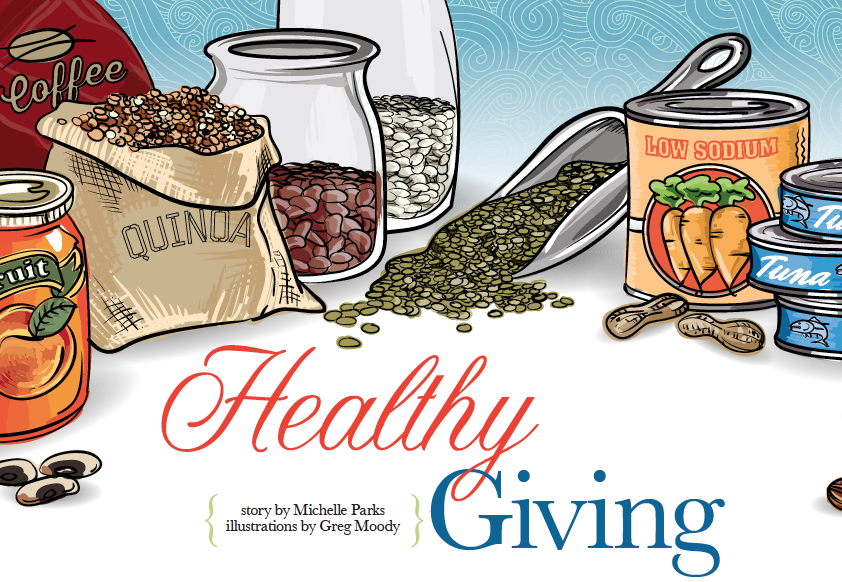Healthy Giving
During the holiday season, many people turn their thoughts to celebrations with family and friends, and to appreciating the abundance in their lives. They also often seek ways to give of themselves, their time, and their resources, to help people in their lives and their communities.
Many organizations, programs, and individuals take on the cause of bettering their communities, particularly during the holidays. But, for those efforts to be most effective and better address real needs, it’s important for donors to understand what is more helpful – and less helpful – to give.
Melissa Terry is programs coordinator for Cultivate Communities, one of Edible Ozarkansas’ “sister” programs within Feed Communities. She said that people who give to food banks, food pantries and community meals programs often do so from an authentic desire to help make a difference.
Typical food drive donations have traditionally focused more on quantity than quality, however. That means that highly processed food items that lack significant nutritional value, or items that are high in carbohydrates, sodium or sugar, have become synonymous with food drives, Terry said. Ramen noodles, boxed macaroni and cheese, and microwavable meals are commonly donated items.
“However, the trend of food pantry donations in Northwest Arkansas and across the country is shifting more toward an emphasis on quality over quantity and the recognition that whole foods are intrinsically more generous donations than processed, nutritionally incomplete foods,” Terry said.
Feed Communities works to promote a program called Donations with Dignity, which refers to shelfstable products that are also high in fiber and protein. Examples of these foods include grains such as brown rice, quinoa and oats, and proteins such as beans, lentils, nuts, nut butters, and canned meats (salmon, tuna, chicken). Low-sodium, canned vegetables, and canned/cupped fruit packed in water are also healthy, helpful items, Terry said.
Adrienne Shaunfield, director of Feed Fayetteville (another “sister” program within Feed Communities), said that the organization strives to help people realize that the items they donate to food banks might be the only thing that people are getting to eat. So, they encourage items that are more nutritious and shelf stable. However, all the food pantries they work with in Northwest Arkansas have refrigeration capabilities, which provides a means to keep produce fresh.
“That’s probably the biggest thing missing in the diets of people who are food insecure,” Shaunfield said of fresh produce.
As people turn their thoughts to giving, they can make a bigger impact on the health of those in need by focusing on giving the most nutritional foods.
“Much like tithing, giving is our way of expressing gratitude for our lives, our families, our friends, our health, and giving during the holiday season is a beautiful thing,” Terry said. “Hosting a healthy food drive with your community group, church or school would be very helpful.”
With that said, however, some 40 percent of all the food grown, purchased and brought into homes in the United States is wasted, Terry said. People can simply help by preventing food waste. As they plan their own or attend parties throughout the year, they could consider donating any leftover food to a community kitchen, Salvation Army kitchen or homeless shelter.
After the frenzy and rush of celebration and giving during the holidays, the needs continue. Being cognizant of that ongoing need is important, Terry said.
“Following the boon donations of the holiday season, February tends to be the ‘hungry month,’ when low-income families and seniors are most in need and pantry shelves tend to become most lean. In many cultures, February is called the hungry moon,” Terry said.
Lack of access to fresh produce is also a prominent issue during late winter and early spring, Terry said.
Providing food to those in need is something the River Valley Regional Food Bank, based in Fort Smith, does every day of the year. The agency works with 216 food pantries in an eightcounty area, serving between 47,000 and 53,000 people each month.
Ted Clemons, director of the food bank, said many people don’t realize that their donations of money would actually go a lot further than donations of food items. Though people like to hold food drives, donating money is the most effective way to help.
“We can do a lot more with a dollar than most people can do with a dollar,” Clemons said. “I’d rather see you invest your dollar in something that could feed more folks.”
For instance, the food bank can buy canned food at about 7 cents per pound. They also work with other food banks across the country to redistribute their excess food supplies. A recent truckload of frozen, tray-packed chicken was purchased from Maryland for 8 cents a pound.
The regional food bank handed out 8 million pounds of food last year. Because of the mass quantities they deal with, they try to stay away from frozen and perishable items. If people do want to donate food, the most needed items are canned meats, canned vegetables, cereal, and dried beans and rice.
Sometimes, people donate older items they find in their home pantries. The health department allows the food bank to extend the dates on some products it accepts, by two years on canned goods. Among donations they’ve received that they don’t need are baby food and baby products. There are other social services programs that handle those needs, he said. “We have Gerber in our backyard, and we don’t even take their product.”
And, the need lasts all throughout the year. This food bank needs the most help from June to September. Donations decrease during that period because most companies give at the beginning or the end of the year for tax breaks. In addition, children are out of school for the summer, so the demand also increases by about 15 to 20 percent.
The food bank plans to move from its current space – a building that is deteriorating – into a former grocery store space on Zero Street. The larger building was given to the organization two years ago, and they are raising money to renovate it for their needs. The facility will allow them to distribute some 12 million pounds of food a year – a 50-percent increase from their current amount. That higher demand already exists, but their current facility limits their ability to meet it, Clemons said.
Companies and individuals who want to give more could donate money for naming opportunities in the renovated facility, as well as for needed equipment such as pallet jacks and a floor scrubber.
Clemons said that volunteers play a big part in the operation. They sort through the donations to make sure the food is edible. During three recent months, an average of 145 volunteers worked each month. In 2012, volunteers worked a total 6,825 hours.
Steady donations year-round would help the most, and some people already give money to the food bank every month. There’s also a way to donate via PayPal from the organization’s Facebook page. “They need to realize a lot of these folks that are in need are their neighbors,” Clemons said. “I think a lot of people just don’t see the folks that are in need in our community.”
Seven Hills Homeless Center in Fayetteville assists with some of the less visible needs in Northwest Arkansas. In operation since 2000, the organization runs a day center on Martin Luther King Jr. Boulevard.
Cynthia Seideman, day center director, said it’s most important for them that people keep the season in mind and donate accordingly. In winter, for instance, the main need is to keep people warm.
About 80 percent of the people they serve either live at a campsite or in their vehicle, or they surf from one friend’s couch to the next. Some technically have a home with a roof over their head, but there’s no running water or electricity. Many of them have limited means of preparing and cooking meals.
The center has a needs list that changes monthly, and people can have that list emailed to them. Items requested this winter, for instance, include heavy winter coats, heavy gloves, umbrellas, rain ponchos, handwarmers, flashlights, C and D batteries, tents and clean sleeping bags. They also need cold, sinus, allergy and flu medications, along with cough drops, as well as manual can openers, deodorant and double-edged razors.
When it comes to donated clothing, it all must be laundered first. Though they have two washers and dryers at the center, they don’t have the capacity to clean what comes in – some of which has been filthy. They don’t need formal wear, business suits or dressy clothes for office jobs. Most people who are searching for work are seeking blue-collar jobs.
Right now, they do need weather-worthy clothing donations for adults that will help get them through the rest of winter, including men’s jeans, T-shirts, white crew socks, men’s and women’s underwear, and men’s tennis shoes and boots.
“A lot of our folks walk a lot, and they need sturdy shoes,” Seideman said.
At the day center, they serve a breakfast and afternoon snack to about 100 people each day, plus lunch on Fridays. Two Fayetteville churches – St. Paul’s Episcopal Church and Central United Methodist Church – take turns serving meals the other four days during the week. Because the center is closed at night and on the weekends, they also issue many food bags for people to take with them.
Rather than volunteering at the center, it’s more helpful that people do things like hold food drives, Seideman said. The center is always in need of shelf-stable foods, such as canned soups, canned vegetables and dry cereals. They tend to get plenty of high-carbohydrate, high-sugar foods, but proteinbased foods, such as canned meats, beans and peanut butter, are also much needed. In the colder months, they also go through a lot more hot chocolate, coffee and creamer.
“It would be most helpful if people could focus on the nutritional side rather than the sugary stuff,” she said. “We’d rather have 10 cans of tuna than 10 dozen cookies.”
While the holiday season typically inspires many people to give, Seideman said the center needs the most help at the first of the year and then from June through September.
“People go crazy during the holidays, and then they forget,” she said.
In the summer, people go on vacations and students are out of school, so the food and clothing drives dwindle. Though the food pantry is virtually bare in the summer months, “we always make it,” she said.
“That holiday glut is really good because that’s what gets us through the rest of the year,” Seideman said. “It’s a balance all the time of managing what you have and making it stretch.”
There are several ways that people could pace their giving year-round and be most helpful to the center. She recommends that people think about giving seasonally, rather than annually. She also suggests that they stay in touch with the center regarding the current needs, which change month to month, rather than focusing on what they want to clear out of their home pantries and closets.
Things they’ve received at the center that weren’t helpful include baseball cleats and wedding dresses. They are, however, always in need of plastic grocery bags, typically going through about 75 each day. Another item that’s very useful for the people they serve: adult-sized backpacks. “If the zippers work and the straps are sturdy, that’s what we need,” Seideman said.
The organizations mentioned here are among dozens that help our neighbors in our communities. No matter the time of year, there is always a need. We encourage you to look around and seek out opportunities to lend your support.
We can each do our part to make a difference, and those individual efforts can add up quickly.





